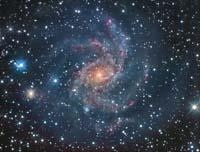More organic molecules in space

A group of international astronomers has announced that in The Astrophysical Journal Letters, in an area far from the center of the Milky Way and 26,000 light-years from Earth, they have discovered a molecule related to the origin of life.
Precisely thanks to the IRAM radio telescope located in the Alps, a glycol aldehyde has been detected in the G31.41+0.31 area. Aldehyde glycol is a monosaccharide that, together with others, forms more complex molecules such as ribose. Ribose is a basic component of RNA.
So far, astronomers have detected more organic molecules, but all of them in the center of the Milky Way. This is the first time they find it outside of it and, according to astronomers, this is important for two reasons. On the one hand, in the center of the Milky Way there is a great radiation that reduces the possibilities of life generation. However, the G31.41+0.31 is far from the center, so if biological processes were initiated they would have more chances to move forward. On the other hand, the high number of glycol aldehyde found suggests that this molecule is common in areas where stars are being produced.
Although there is a wide margin of life generation from the formation of organic molecules, some believe that this discovery reinforces the hypothesis that life on Earth came from space.





